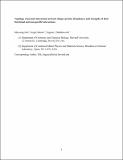| dc.contributor.author | Heo, Muyoung | |
| dc.contributor.author | Maslov, Sergei | |
| dc.contributor.author | Shakhnovich, Eugene Isaacovitch | |
| dc.date.accessioned | 2014-08-19T20:48:27Z | |
| dc.date.issued | 2011 | |
| dc.identifier.citation | Heo, Muyoung, Sergei Maslov, and Eugene Shakhnovich. 2011. Topology of Protein Interaction Network Shapes Protein Abundances and Strengths of Their Functional and Nonspecific Interactions. Proceedings of the National Academy of Sciences 108, no. 10: 4258–4263. | en_US |
| dc.identifier.issn | 0027-8424 | en_US |
| dc.identifier.issn | 1091-6490 | en_US |
| dc.identifier.uri | http://nrs.harvard.edu/urn-3:HUL.InstRepos:12724045 | |
| dc.description.abstract | How do living cells achieve sufficient abundances of functional protein complexes while minimizing promiscuous nonfunctional interactions? Here we study this problem using a first-principle model of the cell whose phenotypic traits are directly determined from its genome through biophysical properties of protein structures and binding interactions in a crowded cellular environment. The model cell includes three independent prototypical pathways, whose topologies of protein–protein interaction (PPI) subnetworks are different, but whose contributions to the cell fitness are equal. Model cells evolve through genotypic mutations and phenotypic protein copy number variations. We found a strong relationship between evolved physical–chemical properties of protein interactions and their abundances due to a “frustration” effect: Strengthening of functional interactions brings about hydrophobic interfaces, which make proteins prone to promiscuous binding. The balancing act is achieved by lowering concentrations of hub proteins while raising solubilities and abundances of functional monomers. On the basis of these principles we generated and analyzed a possible realization of the proteome-wide PPI network in yeast. In this simulation we found that high-throughput affinity capture–mass spectroscopy experiments can detect functional interactions with high fidelity only for high-abundance proteins while missing most interactions for low-abundance proteins. | en_US |
| dc.description.sponsorship | Chemistry and Chemical Biology | en_US |
| dc.language.iso | en_US | en_US |
| dc.publisher | Proceedings of the National Academy of Sciences | en_US |
| dc.relation.isversionof | doi:10.1073/pnas.1009392108 | en_US |
| dc.relation.hasversion | http://www.researchgate.net/profile/Sergei_Maslov/publication/50267106_Topology_of_protein_interaction_network_shapes_protein_abundances_and_strengths_of_their_functional_and_nonspecific_interactions/links/0912f50b38e4b0d837000000 | en_US |
| dc.relation.hasversion | http://www.cmth.bnl.gov/~maslov/Topology_Abundance_PNAS_2011_combined.pdf | en_US |
| dash.license | LAA | |
| dc.subject | genotype-phenotype relationship | en_US |
| dc.subject | a multi-scale evolutionary model cell | en_US |
| dc.subject | evolution of protein interface | en_US |
| dc.title | Topology of Protein Interaction Network Shapes Protein Abundances and Strengths of Their Functional and Nonspecific Interactions | en_US |
| dc.type | Journal Article | en_US |
| dc.description.version | Accepted Manuscript | en_US |
| dc.relation.journal | Proceedings of the National Academy of Sciences | en_US |
| dash.depositing.author | Shakhnovich, Eugene Isaacovitch | |
| dash.waiver | 2011-02-04 | |
| dc.date.available | 2014-08-19T20:48:27Z | |
| dc.identifier.doi | 10.1073/pnas.1009392108 | * |
| dash.contributor.affiliated | Heo, Muyoung | |
| dash.contributor.affiliated | Shakhnovich, Eugene | |


